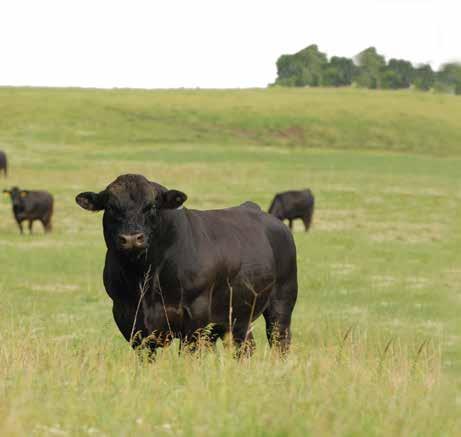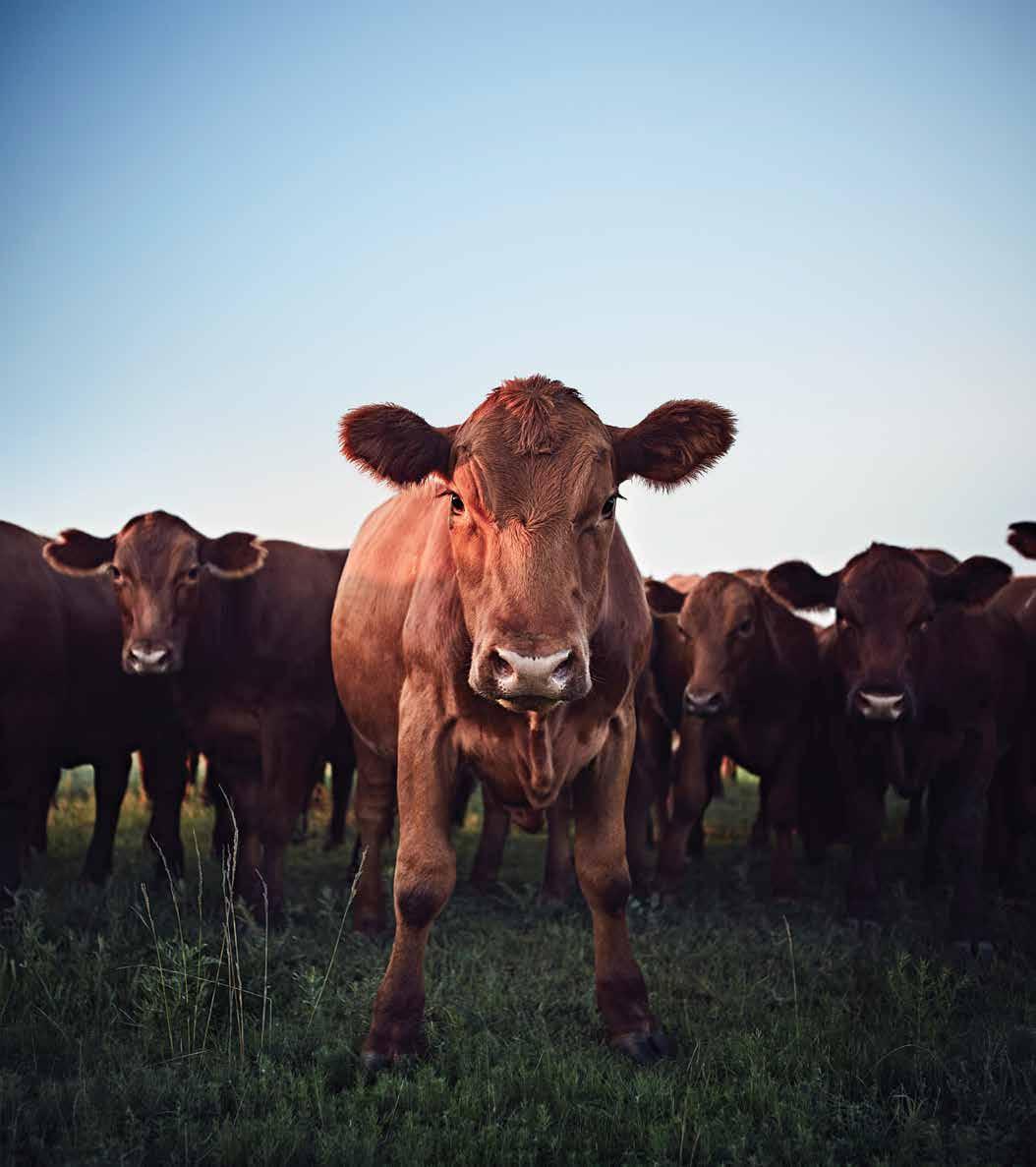
18 minute read
Cattle Prices Set to Strengthen
Cattle Prices Set to Strengthen Beef production this year is poised to grow again and the low cattle prices for the cattle cycle are in the rearview mirror.
By Wes Ishmael
Advertisement
Growing demand and increasing beef prices at the consumer level will be supportive of cattle prices, with leverage beginning to shift away from the packing sector as more shackle space becomes available, according to CattleFax analysts, at that organization’s recent 2020 Industry Outlook in San Antonio.
CattleFax projects fed steer prices to average $120/cwt. during 2020, which would be $3 more than last year. Kevin Good, CattleFax vice president of industry relations and analysis, notes there is downside risk at $108 and resistance at $130.
“With strong demand for U.S. beef at home and rising demand overseas, the modest increases in supply will be more than offset by a growing consum er appetite for our product,” says Good. He projects all-fresh retail prices will av erage $5.87/lb., 5¢ more than in 2019. CattleFax projects average composite cutout prices $3 higher this year at $222/cwt., with a range of $210-$235. “Higher wholesale beef values are a reflection of improving domestic and global beef demand,” Good explains. CattleFax forecasts steer calf prices (550 lbs.) this year $6 higher than last year at an average of $170/cwt., across a range of $155-$180.
“With total cattle inventories at or just past a cyclical peak, feedlot inventories will likely peak in the next few months,” says Derrell Peel, Extension livestock marketing specialist at Oklahoma State University, in recent weekly market comments. “However, average feedlot inventories are currently record large. After peaking last August then declining for two months, the 12-month moving average of feedlot inventories moved higher the last three months and is currently at 11.639 million head, record large for the current data series back to 1996.”
In January, the World Agricultural Supply and Demand Estimates projected 2020 beef production at 27.44 billion lbs., which was 75 million lbs. less (-0.27%) than the December forecast, but still 289 million lbs. more (+1.06%) than in 2019.
As for feeder steer prices (750 lbs.), CattleFax projects an average increase of $6, compared to last year, at an average of $150/cwt., across a range of $140-$160.
CattleFax sees bred cows steady at $1,500, across a full range of $1,200 to $1,800 for load lots of running-age cows. On the input side of the equation, Mike Murphy, CattleFax vice president of research and risk management
services, predicts acres planted to corn will increase 4 million acres to 94 million acres this year and that soybean acres will increase 7 million acres to reach 83 million acres. He pegs spot corn prices at $3.50-$4.00/bu., which would be 15¢ to 20¢/bu. less than last year, notwithstanding significant weather pressure. Herd Expansion Ends, for Now
Based on USDA’s cattle report released Jan. 31, as widely expected, national herd expansion is over.
“Windy”Sons 17866730
Like FATHER







Sale: March 23rd, 2020 @ Noon The Best ofBoth Worlds
Like SONS
4150 Sons 43466018
Monday April 20, 2020


We would like to introduce Sort’n Buddy. This revolutionary remote-controlled gate operator was invented by a rancher for ranchers. This device attaches to any free-swinging gate and is controlled with a rugged, durable handheld remote. This device opens and closes rapidly meeting the demand for sorting cattle.

Our breakaway system allows for that occasional critter that blows by and slams into the gate, allowing it to break away from the control to protect the motor. This system is easy to reattach and continue working. When you’re not sorting, this device can be moved to a pasture gate and you will never have to get out of your vehicle (or off your horse) again to open or close your gate.
We have built in WiFi so if more than 1 person needs access, you can share your code with them instead of your remote. This also has a locking feature for security. This totally self-contained 12v system works in remote locations.
March Weather Conditions can be a Lion or a Lamb for a Cattle Operation. Most Often it is Both. Be Ready with MLS Tub Supplements. Consistent Consumption Every Cow in the herd, gets the same nutrition, with every lick, every time
No Waste Unlike other forms of mineral and protein supplements, low-moisture tubs are totally weather proof Decreased Labor A tub to supplement forage. No extra equipment, no extra fuel, no extra time spent feeding Highly Palatable Mineral and other nutrients can’t work if cows won’t eat them
MLS Low-Moisture Tubs are the Most Valuable Supplement Option
Logan Kennedy 417-592-1764 info@mlstubs.com Jeff Anslinger 816-244-7340 MLS Tub Supplements now available at Farmers and Ranchers Livestock Commission in Salina, KS.
GELBVIEH & BALANCER ®
Smart. Reliable. Profitable.
Gelbvieh and Balancer ® genetics offer more pounds of calf weaned, added fertility, and greater cow herd longevity.

• Beef cows at the beginning of the year of 31.31 million head, were 1.18% less (-374,000 head) than the previous year. “The peak beef cow inventory for 2019 was 31.7 million (revised down by 75,000 head from the previous report),” Peel explains. “This means that the total herd expansion in this cycle was an increase of 2.73 million head from the 2014 low of 29.0 million cows. That is a total cyclical expansion of 9.4% or an average of 1.9% per year for the five years of expansion.” • Beef replacement heifers Jan. 1 of 5.77 million head were 1.92% fewer (-113,000 head) than the previous year. “The inventory of beef replacement heifers is 18.4% of the beef cow inventory, a level that historically has not indicated significant liquidation,” Peel says. “However, in 2019, replacement heifers were 18.6% percent of the beef cow inventory, but sharply higher beef cow slaughter at the end of the year pushed the culling rate fractionally over 10% and resulted in modest reduction in the herd inventory. The number of beef heifers expected to calve in 2020 is 3.5 million head, 0.8% lower year over year.”
States with 1 million or more beef cows at the beginning of the year, and the ranking by size, were the same as a year earlier. In order of size, with Jan. 1 cow numbers in parenthesis: Texas (4.57 million); Oklahoma (2.09 mil lion); Missouri (2.08 million); Nebraska (1.92 million); South Dakota (1.73 mil lion); Kansas (1.43 million); Montana (1.43 million); Kentucky (1.01 million). Of those eight states, beef cow numbers increased year over year in Missouri (+24,000 head or 1.17%) and Kentucky (+4,000 head or 0.39%). For the other six states, year-overyear declines in beef cow numbers ranged from -19,000 head in Nebraska (-0.98%) to -96,000 head in Kansas (-6.28%). • Milk cows Jan. 1 of 9.33 million head were 2.10% less (-113,000 head) than the same time a year earlier. • The 2019 calf crop was estimated at 36.06 million head, which was 0.70% less (-253,100 head) than in 2018 • Cattle on feed Jan. 1—for all feedlots—of 14.68 million head was 2.16% more (309,800 head) than the previous year. That’s the largest January 1 inventory since 2008, according to Peel.
“These numbers show that the last pulse of larger cattle numbers are currently in feedlots and cattle slaughter will be up in the first quarter before declining through the second half of the year,” Peel says. “However, higher carcass weights are projected to offset

a slight decline in cattle slaughter and push total 2020 beef production higher to new record levels. Beef production is likely, however, to be lower year over year by the fourth quarter of the year.” • The estimated feeder cattle supply outside feedlots Jan. 1 of 26.45 million head is 0.40% less (-105,300 head) than a year earlier. • There were 1.61 million head grazing small grain pastures in Kansas, Oklahoma and Texas on Jan. 1. That was 15.26% less (-290,000 head) than a year earlier. • USDA pegs the Jan. 1 inventory of all cattle and calves at 94.41 million head, which is 0.41% less (-391,400 head) than a year earlier. Good notes additional supplies of utility cows, the product of several years of aggressive expansion, are likely to challenge the cull cow market. However, he explains, “Increased demand for lean trim and a decline in the availability of imported grass-fed trim from Australia and New Zealand will be supportive of cow prices.” He projects utility cow prices at an average of $65/ cwt., ranging from the low $70s to a fall low near $55. Cattle Feeding Returns More Positive
In the meantime, cattle feeding economics grow more positive, according to the most recent Historical and Projected Kansas Feedlot Net Returns, from Kansas State University.
Net returns projected for closeouts in December were +$51.13 per head for steers and +$40.44 per head for heifers, according to the report. That’s with estimated feedlot cost of gain (FCOG) of $89.49/cwt. for steers and $95.78 for heifers.
Keep in mind that these estimates are cash to cash and do not account for price risk management.
Moreover, the report projected positive net returns for steers in six of the next eight months, counting January with a range of -$12.44 per head ( June) to +$122.26 ( January), with FCOG of $85.75/cwt. ( July) to $94.77 (February).
KSU projects positive net returns for heifers in the next eight months, ranging from +$3.60 (August) to +$146.75 ( January) with FCOG of $93.01 (August) to $99.88 (February). Beef Exports Help Offset Increased Production
“Given that red meat production is expected to remain elevated in 2020, it points to the importance of being able to export pork and beef,” says Andrew P. Griffith, agricultural econ -
NO LIGHTWEIGHTS omist at the University of Tennessee is recent market comments.
U.S. beef exports last year totaled 1.32 million metric tons (mt), 2.5% below the previous year’s record volume, according to data released by USDA and compiled by the U.S. Meat Export Federation (USMEF). Beef export value was 3% less at $8.1 billion. Beef export value per head of fed slaughter last year was $309.75, down 4% (see “Gone Global”).
“There is strong demand for our product, but that’s the result of the fact that our business has paid attention to market signals and we’ve been producing a consistent, quality product that has gained a greater piece of that retail dollar. We need to protect that,” says Randy Blach, CattleFax CEO. “We must pay attention to what the consumer is telling us. That means conversations about topics like traceability and sustainability only become more important as time goes on. We have to listen to the consumer and respond with action to meet their needs and demands if we’re going to continue to be successful in a hypercompetitive global protein market.”
“Market conditions in 2020 will determine the trajectory of the cattle industry from this point forward,” Peel says. “Modestly higher prices are projected in 2020, combined with improved international market potential, could restart herd expansion. Alternatively, continued political and economic turbulence or shocks, such as coronavirus, could drag markets down and hold cattle inventories flat or fall into more liquidation.” Editor’s Note: In addition to his writings for F&R Livestock Resource, Wes Ishmael also writes and produces Cattle Current—a convenient, one-stop glance at daily cattle markets. The website and daily podcast include market highlights. The daily Cattle Current e-mail newsletter includes more detail: Highlights from and links to calf and feeder cattle auctions monitored by Cattle Current; weekly market summary commentary; daily cash grain prices; futures prices for live cattle, feeder cattle, corn and Crude oil (day, previous day and previous week). For more information, visit cattlecurrent.com. “Market conditions in 2020 will determine the trajectory of the cattle industry from this point forward.”

Simmental calves are champions of the scale. They reliably outperform straightbred calves in the feedyard – with better growth, better structure and fewer health problems.
They add pounds without sacrificing marbling, and they earn more with the IGS Feeder Profit Calculator, ™ which factors genetics, health and management into true value.
Want low-risk, high-potential calves with earning capability?
STAND STRONG SIMMENTAL
Extended-Release Injectable Parasiticide 5% Sterile Solution For the Treatment and Control of Internal and External Parasites of Cattle on Pasture with Persistent Effectiveness Not for use in female dairy cattle 20 months of age or older, including dry dairy cows. Not for use in calves to be processed for veal. Not for use in breeding bulls, or in calves less than 3 months of age. Not for use in cattle managed in feedlots or under intensive rotational grazing. CAUTION: Federal law restricts this drug to use by or on the order of a licensed veterinarian. INDICATIONS FOR USE LONGRANGE, when administered at the recommended dose volume of 1 mL per 110 lb (50 kg) body weight, is effective in the treatment and control of the following internal and external parasites of cattle:
Gastrointestinal Roundworms Lungworms Bunostomum phlebotomum – Adults and L 4
Dictyocaulus viviparus – Adults Cooperia oncophora – Adults and L 4 Cooperia punctata – Adults and L 4 Cooperia surnabada – Adults and L 4 Grubs Haemonchus placei – Adults
Hypoderma bovis Oesophagostomum radiatum – Adults Ostertagia lyrata – Adults Mites Ostertagia ostertagi – Adults, L 4 and inhibited L 4
Sarcoptes scabiei var. bovis Trichostrongylus axei – Adults and L 4 Trichostrongylus colubriformis – Adults Gastrointestinal Roundworms Lungworms Bunostomum phlebotomum – Adults and L 4 Dictyocaulus viviparus – Adults Cooperia oncophora – Adults and L 4 Cooperia punctata – Adults and L 4 Cooperia surnabada – Adults and L 4 Haemonchus placei – Adults Grubs Oesophagostomum radiatum – Adults Hypoderma bovis Ostertagia lyrata – Adults Ostertagia ostertagi – Adults, L 4 , and inhibited L 4 Trichostrongylus axei – Adults and L 4 Mites Trichostrongylus colubriformis – Adults Sarcoptes scabiei var. bovis Persistent Activity
Parasites Durations of Persistent Effectiveness Gastrointestinal Roundworms Bunostomum phlebotomum 150 days Cooperia oncophora 100 days Cooperia punctata 100 days Haemonchus placei 120 days Oesophagostomum radiatum 120 days Ostertagia lyrata 120 days Ostertagia ostertagi 120 days Trichostrongylus axei 100 days Lungworms Dictyocaulus viviparus 150 days the following parasites for the indicated amounts of time following treatment: Parasites Durations of Gastrointestinal Roundworms Bunostomum phlebotomum 150 days Cooperia oncophora 100 days Cooperia punctata 100 days Haemonchus placei 120 days Oesophagostomum radiatum 120 days Ostertagia lyrata 120 days Ostertagia ostertagi 120 days Trichostrongylus axei 100 days Lungworms Dictyocaulus viviparus 150 days
DOSAGE AND ADMINISTRATION LONGRANGE® (eprinomectin) should be given only by subcutaneous injection in front of the shoulder at the recommended dosage level of 1 mg eprinomectin per kg body weight (1 mL per 110 lb body weight). Each mL of LONGRANGE contains 50 mg of eprinomectin, sufficient to treat 110 lb (50 kg) body weight. Divide doses greater than 10 mL between two injection sites to reduce occasional discomfort or site reaction. Do not underdose. Ensure each animal receives a complete dose based on a current body weight. Underdosing may result in ineffective treatment, and encourage the development of parasite resistance. LONGRANGE is to be given subcutaneously only. Animals should be appropriately restrained to achieve the proper route of administration. Inject under the loose skin in front of the shoulder (see illustration) using a 16 or 18 gauge, ½ to ¾ inch needle. Sanitize the injection site by applying a suitable disinfectant. Clean, properly disinfected needles should be used to reduce the potential for injection site infections. Withdrawal Periods and Residue Warnings Animals intended for human consumption must not be slaughtered within 48 days of the last treatment. This drug product is not approved for use in female dairy cattle 20 months of age or older, including dry dairy cows. Use in these cattle may cause drug residues in milk and/or in calves born to these cows. A withdrawal period has not been established for pre-ruminating calves. Do not use in calves to be processed for veal. Animal Safety Warnings and Precautions The product is likely to cause tissue damage at the site of injection, including possible granulomas and necrosis. These reactions have disappeared without treatment. Local tissue reaction may result in trim loss of edible tissue at slaughter. Observe cattle for injection site reactions. If injection site reactions are suspected, consult your veterinarian. This product is not for intravenous or intramuscular use. Protect product from light. LONGRANGE® (eprinomectin) has been developed specifically for use in cattle only. This product should not be used in other animal species. When to Treat Cattle with Grubs LONGRANGE effectively controls all stages of cattle grubs. However, proper timing of treatment is important. For the most effective results, cattle should be treated as soon as possible after the end of the heel fly (warble fly) season. Environmental Hazards Not for use in cattle managed in feedlots or under intensive rotational grazing because the environmental impact has not been evaluated for these scenarios. Other Warnings: Parasite resistance may develop to any dewormer, and has been reported for most classes of dewormers. Treatment with a dewormer used in conjunction with parasite management practices appropriate to the geographic area and the animal(s) to be treated may slow the development of parasite resistance. Fecal examinations or other diagnostic tests and parasite management history should be used to determine if the product is appropriate for the herd/flock, prior to the use of any dewormer. Following the use of any dewormer, effectiveness of treatment should be monitored (for example, with the use of a fecal egg count reduction test or another appropriate method). A decrease in a drug’s effectiveness over time as calculated by fecal egg count reduction tests may indicate the development of resistance to the dewormer administered. Your parasite management plan should be adjusted accordingly based on regular monitoring. Macrocyclic lactones provide prolonged drug exposure that may increase selection pressure for resistant parasites. This effect may be more pronounced in extendedrelease formulations. TARGET ANIMAL SAFETY Clinical studies have demonstrated the wide margin of safety of LONGRANGE® (eprinomectin). Overdosing at 3 to 5 times the recommended dose resulted in a statistically significant reduction in average weight gain when compared to the group tested at label dose. Treatment-related lesions observed in most cattle administered the product included swelling, hyperemia, or necrosis in the subcutaneous tissue of the skin. The administration of LONGRANGE at 3 times the recommended therapeutic dose had no adverse reproductive effects on beef cows at all stages of breeding or pregnancy or on their calves. Not for use in bulls, as reproductive safety testing has not been conducted in males intended for breeding or actively breeding. Not for use in calves less than 3 months of age because safety testing has not been conducted in calves less than 3 months of age. STORAGE Store at 77° F (25° C) with excursions between 59° and 86° F (15° and 30° C). Protect from light. Approved by FDA under NADA # 141-327 Made in Canada. Manufactured for Boehringer Ingelheim Animal Health USA Inc., Duluth, GA 30096 ®The Cattle Head Logo and ®LONGRANGE are registered trademarks of Boehringer Ingelheim Animal Health USA Inc. © 2019 Boehringer Ingelheim Animal Health USA Inc. All rights reserved.1050-2889-08, Rev. 01/2019, 8LON016E US-BOV-0277-2019 DOSAGE AND ADMINISTRATION LONGRANGE® (eprinomectin) should be given only by subcutaneous injection in front of the shoulder at the recommended dosage level of 1 mg eprinomectin per kg body weight (1 mL per 110 lb body weight). Each mL of LONGRANGE contains to treat 110 lb (50 kg) body weight. Divide doses greater than 10 mL between two injection sites to reduce occasional discomfort or site reaction. Body Weight (lb) Dose Volume (mL) 110 1 220 2 330 3 440 4 550 5 660 6 770 7 880 8 990 9 1100 10
Visit theLONGRANGElook.com to learn more. By delivering up to 150 days of parasite control with just one dose 2 , LongRange ® (eprinomectin) offers the best economic return of any dewormer on the market. The season-long protection provided by Theraphase ® technology means greater defense against nutrient-robbing parasites — and ultimately, heftier cattle.
Visit theLONGRANGElook.com to learn more.
MORE POUNDS THAN
Dectomax ® (doramectin). 3

WORTH ITS WEIGHT IN POUNDS.
LONGRANGE IMPORTANT SAFETY INFORMATION: Do not treat within 48 days of slaughter. Not for use in female dairy cattle 20 months of age or older, including dry dairy cows, or in veal calves. Post-injection site damage (e.g., granulomas, necrosis) can occur. These reactions have disappeared without treatment. Not for use in breeding bulls, or in calves less than 3 months of age. Not for use in cattle managed in feedlots or under intensive rotational grazing.
1 Results based on actual on-farm comparative demonstration. Individual herd results may vary. Data on file at Boehringer Ingelheim. 2 Dependent upon parasite species, as referenced in FOI summary and LONGRANGE product label. 3 DECTOMAX product label.
Available in 500 mL, 250 mL and 100 mL bottles. Administer subcutaneously at 1 mL/110 lbs.






